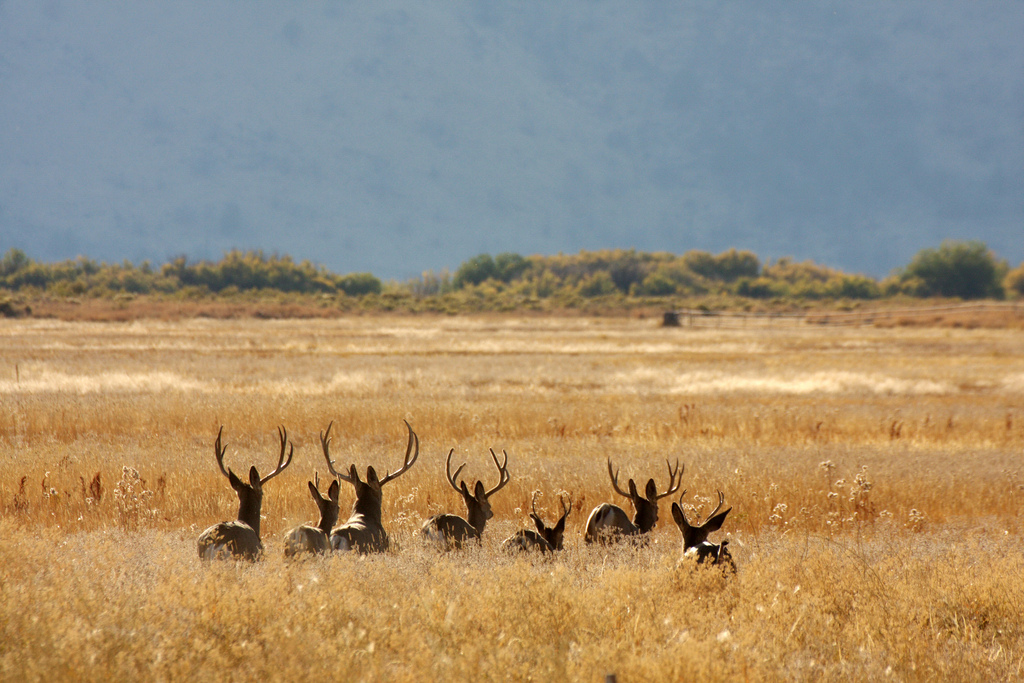USA needs a sustained national ecosystem assessment
By Cliff Duke, ESA’s director of Science Programs

Mule deer bucks move across Malheur National Wildlife Refuge, a wetland oasis in dry southeastern Oregon. Deer share the refuge seasonally with grazing livestock and hundreds of species of migrating birds. President Theodore Roosevelt, an avid hunter, established the refuge in 1908 to revive North American bird populations hard hit by plume hunters pursuing breeding feathers for fancy hats. Armed protesters occupied the refuge in January 2016, escalating tensions over the ownership and management of public lands in the United States. Credit, Barbara Wheeler/USFWS CC BY 2.0.
Americans are deeply divided about the proper uses of federal and private lands and the goods and services they supply us. Recent events, including the acquittal of the occupiers of the Malheur National Wildlife Refuge, protests of the proposed Dakota Access Pipeline, and the potential reopening of debates about the Keystone XL Pipeline, illustrate these value differences.
Scientists seek to bridge the divide with data and analysis. Today in Science magazine, U.S. Geological Survey ecologist Stephen Jackson and colleagues call for a national assessment of ecosystem trends. Citing examples of environmental change in which a national assessment could inform responses, such as drought in southwestern states, decline of native bees in Hawaii, and Gulf Coast restoration, the authors propose a public-private partnership, “between NGOs, philanthropic foundations, private-sector entities, agencies of the U.S. Government, and selected state, local and tribal agencies” to assess the status of the nation’s biodiversity and ecosystem services.
In an editorial in BioScience, Osvaldo Sala (2016) proposes a role for scientific measurement in resolving conflicts over land use, stating that
“Measuring ecosystem services and the demands from stakeholders may assist in conflict resolution by shifting the discussion from an emotion-based conflict to an evidence-based negotiation in which many novel options are in play. Then, it would be possible to assess whether there are trade-offs among the demands of different stakeholders.”
This optimistic view of the contributions of ecosystem service measurement to decision-making is echoed by Matthias Schröter et al. (2016):
“In order to safeguard biodiversity and the services that ecosystems provide to humans, national ecosystem assessments (NEAs) form an essential knowledge base to inform decisionmaking in policy and practice.”
Effective monitoring of biodiversity and ecosystem services is also key to meeting national conservation goals (Aycrigg et al. 2016) and responding to the continuing global impacts of climate change (Scheffers et al. 2016).
In response, Jackson et al. (2016) call for an ongoing national assessment of ecosystem functioning. They argue that
“A systematic national assessment program is needed to identify potential risks, determine priorities, identify trends, and evaluate decisions and actions . . . without the context and reference points provided by a comprehensive national assessment, it will be difficult to assess benefits of government decisions aimed at enhancing or protecting ecosystem services.”
Jackson et al., all members of ESA’s Steering Committee for the Intergovernmental Platform on Biodiversity and Ecosystem Services (IPBES), further note the U.S. government played a leading role in creating IPBES, an international organization that is conducting global and regional assessments of biodiversity and ecosystem services. Many U.S. scientists are contributing to these ongoing studies as well as to a global study of pollination services completed this year. While these assessments are important, they are at too large a scale to substitute for a national assessment. For example, the Americas regional assessment covers all of North, Central, and South America and the Caribbean. A national assessment would provide focused information of direct relevance to national decision makers and would reinforce U.S. leadership in environmental stewardship.
The election results last week may affect the direction and focus of U.S. environmental policy, but they do not alter the need for the United States to responsibly manage its public lands and natural resources. Now more than ever we need to place as much importance on monitoring biodiversity and ecosystem services as we do on monitoring the economic and public health of the nation.
References
J.L. Aycrigg, C. Groves, J.A. Hilty, J.M. Scott, P. Beier, D.A. Boyce, Jr., D. Figg, H. Hamilton, G. Machlis, K. Muller, K.V. Rosenberg, R.M. Sauvajot, M. Shaffer, and R. Wentworth. 2016. Completing the system: opportunities and challenges for a national habitat conservation system. BioScience 66:774-784. doi: 10.1093/biosci/biw090
Jackson, S.T., C.S. Duke, S.E. Hampton, K.L. Jacobs, L.N. Joppa, K.-A. S. Kassam, H.A. Mooney, L.A. Ogden, M. Ruckelshaus, and J.F. Shogren. 2016. Toward a national, sustained U.S. ecosystem assessment. Science 354: 838-837. DOI: 10.1126/science.aah5750
Sala, O. 2016. How scientists can help end the land-use conflict. BioScience 66:915. doi: 10.1093/biosci/biw145
Scheffers, B.R., L. De Meester, T.C.L. Bridge, A.A. Hoffmann, J.M. Pandolfi, R.T. Corlett, S.H.M. Butchart, P. Pearce-Kelly, K.M. Kovacs, D. Dudgeon, M. Pacifici, C. Rondinini, W.B. Foden, T.G. Martin, C. Mora, D. Bickford, and J.E.M. Watson. 2016. The broad footprint of climate change from genes to biomes to people. Science 354: 719. DOI: 10.1126/science.aaf7671